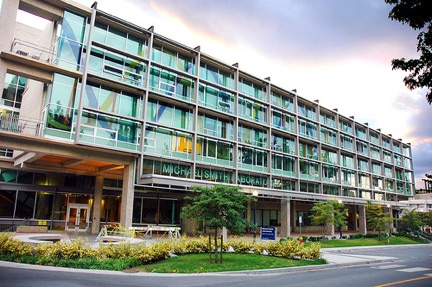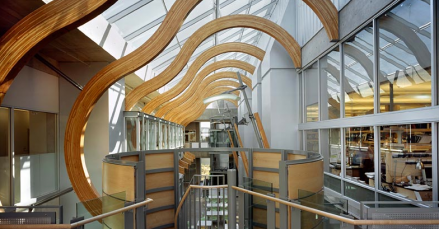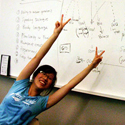Team:British Columbia/Notebook/Brainstorming
From 2011.igem.org
| Line 1: | Line 1: | ||
{{Template:Notebook}} | {{Template:Notebook}} | ||
| - | == | + | ==First 2 weeks of May== |
| + | |||
| + | '''Brainstorming''' | ||
<html> | <html> | ||
<img src="http://www.bioteach.ubc.ca/wp-content/uploads/2008/08/msl.jpg"><br></br></html> | <img src="http://www.bioteach.ubc.ca/wp-content/uploads/2008/08/msl.jpg"><br></br></html> | ||
| - | A week after the UBC iGEM 2011 team was formed, we got together at the beautiful Michael Smith Laboratories and brainstormed potential synthetic biology projects. These were some of the ideas and topics floating around: | + | A week after the UBC iGEM 2011 team was formed, we got together at the beautiful Michael Smith Laboratories (MSL) and brainstormed potential synthetic biology projects. These were some of the ideas and topics floating around: |
*Optogenetics | *Optogenetics | ||
| Line 19: | Line 21: | ||
*Temperature-sensitive inteins | *Temperature-sensitive inteins | ||
| - | Each team member brought an idea home and did background research to determine how feasible these ideas were. After more discussion | + | Each team member brought an idea home and did background research to determine how feasible these ideas were. After more discussion clarifying what we knew and what we didn't know, it boiled down to a decision between (1) cloning cholera receptors into probiotics and (2) transforming microbes with pine beetle pheromones to gather and eradicate pine beetles. |
<html><img src="http://upload.wikimedia.org/wikipedia/commons/f/f6/Vibrio_cholerae.jpg" height=180px> | <html><img src="http://upload.wikimedia.org/wikipedia/commons/f/f6/Vibrio_cholerae.jpg" height=180px> | ||
| Line 26: | Line 28: | ||
</html> | </html> | ||
| - | Everyone was passionate about the pine beetle project because of the relevant applications to the forests of British Columbia. | + | Everyone was passionate about the pine beetle project because of the relevant applications to the forests of British Columbia. Furthermore, there is expertise close at home: the Bohlmann lab in the MSL. Team members from the 2010 iGEM team learnt that it was difficult to obtain resources and collaborate with scientists who were not in the same country. We decided to keep on doing more background reading to develop the project plan, as well as begin contacting researchers working in this field to see what they thought of our ideas. |
| - | + | After a couple of days, the team met up to discuss the pine beetle project in more detail: the objectives, future applications/implications, parts/resources we required, the wet lab, modeling, and human practices components. | |
| + | |||
| + | '''Training''' | ||
<html> | <html> | ||
| Line 34: | Line 38: | ||
</html> | </html> | ||
| - | + | Dr. Joanne Fox began a week of iGEM laboratory training in AMBL, the teaching lab in the MSL. The training sessions ran from 10am-4pm. Joanne provided short lectures so everyone could understand the magic of cloning: using purification kits, performing CIP assays and ligations etc. We performed restriction digests and ligations of insert and vector components, which were transformed into bacteria and plated on agar. | |
| - | + | In between experiments, Marianne and Vicki (returning team members) went over labeling etiquette, lab book organization and the 3-antibiotic method. | |
| - | + | The team then did plate analysis and started cultures for plasmid preps. Not everyone had successful transformations (colonies on their plates), so some had to steal others' colonies to start the culture... | |
| - | + | ==3rd week of May== | |
| - | + | Mondays are when we have our weekly open lab meetings where interested faculty as well as iGEM student club members attend to hear about our project and provide input. We presented our project proposal to our advisors and faculty: Joanne Fox, Leonard Foster, Phil Hieter, Joerg Bohlmann and Chris Keeling, who generously agreed to help us obtain our necessary wet lab components such as genes encoding monoterpene synthases. | |
| - | + | ||
| - | + | ||
| - | + | ||
| - | + | ||
| - | + | ||
| - | + | ||
| - | + | ||
| - | + | ||
| - | + | ||
| - | + | ||
| - | + | ||
| - | + | ||
| - | + | ||
| - | Mondays are when we have our weekly open lab meetings where interested faculty | + | |
[[File:canucksubc.jpg]] | [[File:canucksubc.jpg]] | ||
| - | + | This week, we also had our first iGEM team social = bonding time! We all went to the Indian Oven to have dinner, discuss our project and watch a part of the hockey game (Go Canucks!). It was semi-productive in terms of project discussion. | |
| - | + | ||
| - | + | ||
| - | + | ||
| - | + | ||
| - | + | ||
| - | + | ||
| - | + | ||
| - | + | ||
| - | + | ||
| - | + | ||
| - | + | ||
| - | + | ||
| - | + | Before the week ended, we had our first modeling meeting at Blenz. Our modeling advisor, Shing provided guidance on the different modeling ideas we had: | |
| - | + | *Modeling monoterpene production by yeast | |
| + | *Using google Earth to predict the spread of the pine beetle infestation and the effects of a synthetic biology intervention | ||
| + | *Using synthase and transporter protein homologues to predict target specificity | ||
| - | ==May | + | ==4th week of May== |
| - | + | Because Monday (the 23rd) was Victoria Day, we had our lab meeting on Tuesday. Prior to the meeting, Daisy presented Chris Keeling's 2011 Transcriptome Mining paper. We discussed the methods section and outlined the reagents, protocols and any equipment that we might need to characterize monoterpene synthases. Sam and Gurpal found papers from Greece and France that used variants of metabolic genes (mutant erg20-2, IDI1) to increase the yield of monoterpenes by yeast. | |
| - | The | + | The team discussed possible sub-projects and came up with a "Synthase" track and an "Extra parts" track. Marianne, Vicki, Daisy, Jacob, and Joe will work on the "Synthase" track, each taking on a different synthase; Gurpal and Sam will be on the "Extra parts" track, liaising with the researchers in Greece and France to obtain the relevant plasmids/genes. Vicki took charge of the sponsorship package so everyone could begin contacting potential sponsors. |
| - | + | This week, we also finally secured a lab space (Thank you Ellis Lab!) and began moving equipment, unpacking, organizing and ordering supplies and reagents. | |
| - | Jacob and Joe | + | For our modeling project, Gurpal started working on the model of monoterpene production in yeast by drawing out the biological pathways involved. He found that Matlab would be the best program to use and went through the SimBiology Kit Tutorials. Jacob and Joe began research on how to create a model of the pine beetle infestation and started contacting relevant professors at UBC. |
Revision as of 02:13, 4 August 2011

 |
 |
 |
 |
 |
First 2 weeks of May
Brainstorming

A week after the UBC iGEM 2011 team was formed, we got together at the beautiful Michael Smith Laboratories (MSL) and brainstormed potential synthetic biology projects. These were some of the ideas and topics floating around:
- Optogenetics
- Chemo-signalling (using antibodies as signals)
- Re-routing networks (creating fusion proteins that make extra interactions to interfere with natural protein links)
- Eradicating bed bugs
- Eradicating pine beetles
- Tackling battery waste
- Photo-dynamic inhibition (bacteria are killed by light)
- Using bacteria to clean water
- Using probiotics to tackle cholera
- Temperature-sensitive inteins
Each team member brought an idea home and did background research to determine how feasible these ideas were. After more discussion clarifying what we knew and what we didn't know, it boiled down to a decision between (1) cloning cholera receptors into probiotics and (2) transforming microbes with pine beetle pheromones to gather and eradicate pine beetles.

From left to right: an electron microscope image of Vibrio cholera, a view from Mount Fraser of the pine beetle infestation and dying red trees.
Everyone was passionate about the pine beetle project because of the relevant applications to the forests of British Columbia. Furthermore, there is expertise close at home: the Bohlmann lab in the MSL. Team members from the 2010 iGEM team learnt that it was difficult to obtain resources and collaborate with scientists who were not in the same country. We decided to keep on doing more background reading to develop the project plan, as well as begin contacting researchers working in this field to see what they thought of our ideas.
After a couple of days, the team met up to discuss the pine beetle project in more detail: the objectives, future applications/implications, parts/resources we required, the wet lab, modeling, and human practices components.
Training

Dr. Joanne Fox began a week of iGEM laboratory training in AMBL, the teaching lab in the MSL. The training sessions ran from 10am-4pm. Joanne provided short lectures so everyone could understand the magic of cloning: using purification kits, performing CIP assays and ligations etc. We performed restriction digests and ligations of insert and vector components, which were transformed into bacteria and plated on agar.
In between experiments, Marianne and Vicki (returning team members) went over labeling etiquette, lab book organization and the 3-antibiotic method.
The team then did plate analysis and started cultures for plasmid preps. Not everyone had successful transformations (colonies on their plates), so some had to steal others' colonies to start the culture...
3rd week of May
Mondays are when we have our weekly open lab meetings where interested faculty as well as iGEM student club members attend to hear about our project and provide input. We presented our project proposal to our advisors and faculty: Joanne Fox, Leonard Foster, Phil Hieter, Joerg Bohlmann and Chris Keeling, who generously agreed to help us obtain our necessary wet lab components such as genes encoding monoterpene synthases.
This week, we also had our first iGEM team social = bonding time! We all went to the Indian Oven to have dinner, discuss our project and watch a part of the hockey game (Go Canucks!). It was semi-productive in terms of project discussion.
Before the week ended, we had our first modeling meeting at Blenz. Our modeling advisor, Shing provided guidance on the different modeling ideas we had:
- Modeling monoterpene production by yeast
- Using google Earth to predict the spread of the pine beetle infestation and the effects of a synthetic biology intervention
- Using synthase and transporter protein homologues to predict target specificity
4th week of May
Because Monday (the 23rd) was Victoria Day, we had our lab meeting on Tuesday. Prior to the meeting, Daisy presented Chris Keeling's 2011 Transcriptome Mining paper. We discussed the methods section and outlined the reagents, protocols and any equipment that we might need to characterize monoterpene synthases. Sam and Gurpal found papers from Greece and France that used variants of metabolic genes (mutant erg20-2, IDI1) to increase the yield of monoterpenes by yeast.
The team discussed possible sub-projects and came up with a "Synthase" track and an "Extra parts" track. Marianne, Vicki, Daisy, Jacob, and Joe will work on the "Synthase" track, each taking on a different synthase; Gurpal and Sam will be on the "Extra parts" track, liaising with the researchers in Greece and France to obtain the relevant plasmids/genes. Vicki took charge of the sponsorship package so everyone could begin contacting potential sponsors.
This week, we also finally secured a lab space (Thank you Ellis Lab!) and began moving equipment, unpacking, organizing and ordering supplies and reagents.
For our modeling project, Gurpal started working on the model of monoterpene production in yeast by drawing out the biological pathways involved. He found that Matlab would be the best program to use and went through the SimBiology Kit Tutorials. Jacob and Joe began research on how to create a model of the pine beetle infestation and started contacting relevant professors at UBC.
 "
"















